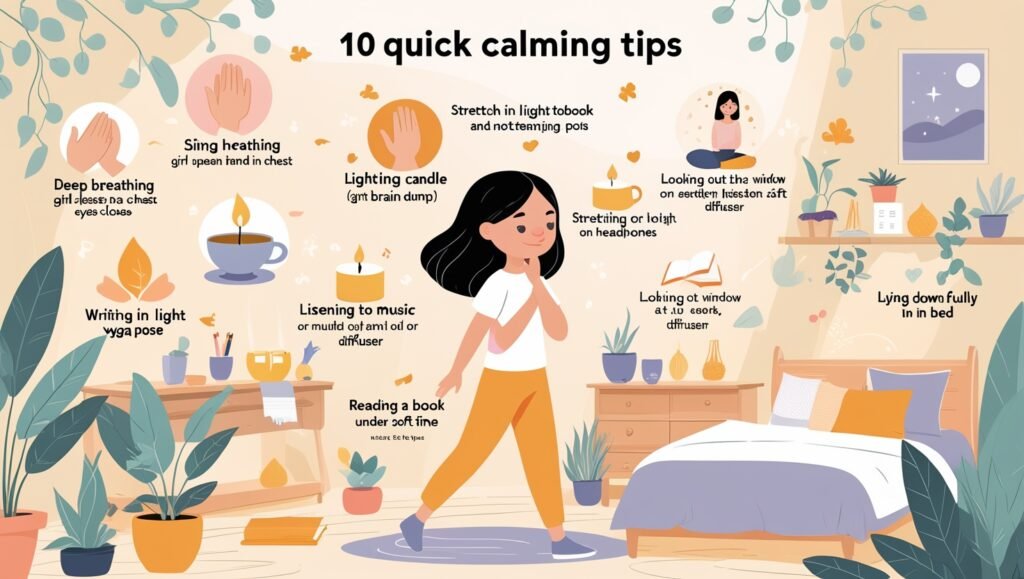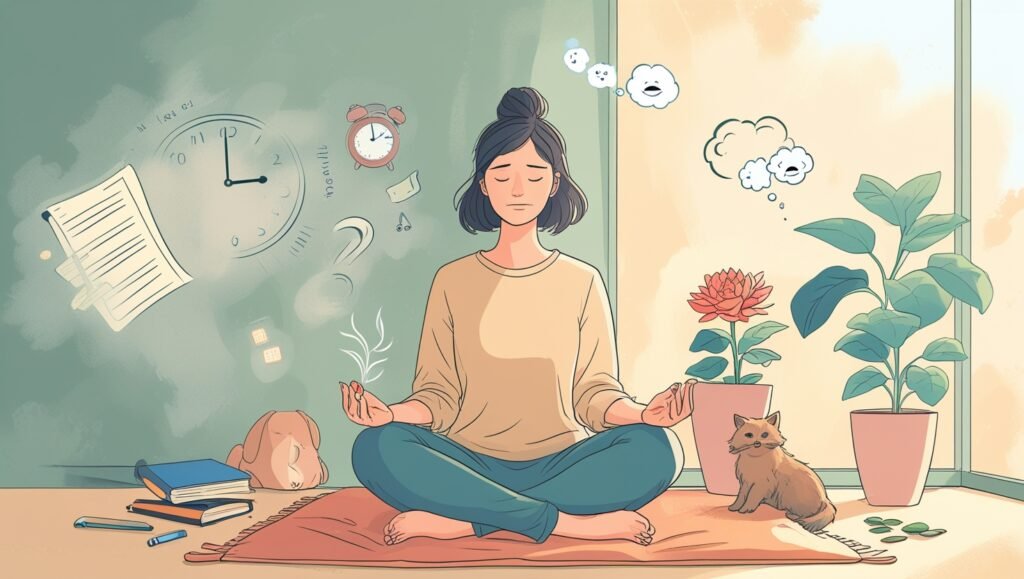10 Quick Tips to Calm Your Racing Thought
Racing thoughts are fast, repetitive thought patterns that you cannot control. These out-of-control thoughts are not only symptomatic of a bipolar mood episode, but people with bipolar disorder may struggle with racing thoughts even when they are not in the middle of a mood episode. They can also create mental fog, interfere with sleep, and disturb the peace. At times, these thoughts escalate to worst-case scenarios, which can seem like an intrusive voice or a continual stream of mental chatter.
Simple tricks like deep breathing, an engrossing activity, or exercise can slow them down. Repeated, untreated, or resistant cases may require treatment of underlying medical conditions, psychiatric therapy, or medication for a cure.
How to Stop Racing Thoughts?
Racing thoughts are just what they sound like — your mind is racing at top speed, often jumping from one thing to the next, one worry to another, some type of fear to another, or some type of idea to another. These thoughts can keep you from being able to focus, sleep or be calm.

What Causes Racing Thoughts?
Racing thoughts don’t just come out of nowhere. There are multiple potential triggers for them:
Stress and Anxiety: When you are in a state of apprehension about work, a relationship or changes in your life, your brain can become stuck in problem-solving mode, forming anxious loops of thinking.
Mental Health Issues: Racing thoughts are a symptom of anxiety disorders, depression, bipolar disorder, and ADHD. When they’re in the grips of a manic episode of bipolar disorder, thoughts can race so quickly that the person has difficulty keeping up, let alone use a brake to slow them down.
Physical Causes: If you’re not getting enough sleep, drinking a lot of caffeine, or taking medication, it may be speeding up your thoughts. Even merely being hungry or thirsty can change how your brain functions.
Life Changes: Major events, like moving, getting a new job, breaking up with someone, or having someone close to you pass on can fill your mind with thoughts and worries.
Overthinking: There are some who are natural overthinkers. This is all good, except it leads to getting stuck in thought loops.
You May Like: 100 Positive Affirmations for Stress and Anxiety Relief
Focus on Now

One of the greatest things you can do to convince your racing thoughts to slow down is to focus on the present. When your mind is galloping, it is typically off racing through your future worries or your past regrets, not focused on what is happening right now.
The 5-4-3-2-1 Technique: A simple technique that engages your senses to keep you grounded in the present:
Write down 5 things you can see. Rows of houses Shops Alligator sausages Golden rule posters (do they still make those?)Santa’s little helper.
- Be mindful of 4 things you can touch or feel.
- Listen for 3 different sounds
- Find 2 things you can smell
- List 1 thing that you can taste-
Mindful Observation: Choose one item near you and study it carefully. Observe the color, texture, shape and size of it. This provides your racing mind with something specific to focus on instead of hopping from one worry to another.
Body Awareness: Notice how your body feels right now. Feel if your shoulders are crunched toward your ears, if your jaw is tight, or where on your body you feel best. This links you in to physical sensations in the present.
Take deep breaths
Your breath and your mind are more connected than you may realize. During the times when thoughts are racing, your tendency may be to breath shallow and fast. When you slow down your breath, you can slow down your mind as well.
4-7-8 Breathing: This is a simple yet powerful technique:
- Inhale (nose) 4 counts
- Hold your breath for 7 counts
- Breathe out (out through mouth) for the count of 8.
- Repeat 3-4 times
- Box Breathing: Picture a box as you breath:
- Breathe in 4 counts (whilst drawing one side of the square)
- Hold for count of 4 (2nd side)
- Breathe out again 4 counts (third side)
- V Hold for a count of 4 (fourth side)
Natural Breathing: Occasionally, simply focusing on your natural breath without making any attempt to change it can be as soothing as an intentional breathing exercise. Count your breaths and exhale from 1 through 10, repeating the cycle.

Think About Other Options
Racing thoughts often pile up, creating situations that are all bad or where there are no choices. Taking time to process things from another perspective can help.
*Question Your Own Thoughts:
- Consider whether this is true or not.
- Am I assuming the worst will happen?
- What advice would I give to a friend?
- What’s actually going to happen, not what is the worst that could happen?
- Can I come up with three different outcomes if this worries me? This way, I remind this brain that there is usually more than one possibility, not just the scary ones my thoughts tend to race towards.
*Challenge Catastrophic Thoughts: Those thoughts frequently leap to the worst-case scenario. I reply, “What’s the evidence that this will happen?” when I begin to notice my thoughts do this. Usually, I find that my fears are more emotional than they are factual.
Use Mantras

Mantras are brief phrases or words you can say to help calm your mind and refocus your thoughts. They function by providing your brain with something stable to hold onto, instead of jumping from one worry to the next.
Calming Mantras:
- “This feeling will pass”
- “I am safe right now”
- “One breath at a time”
- “I can handle this”
- “Peace begins with me”
How to Use Mantras: Select one of these words to use. Do it very slowly, aloud or in your head. You can sound it with each exhalation, or just whenever you notice your thoughts are charging along.
Personal Mantras: You can develop your own mantras to work for what you need to hear. Perhaps it’s “I am enough” if you suffer from self-doubt, or “Everything has a solution” if you are prone to feeling overwhelmed by problems.
Try Distractions
Sometimes, the best way to put an end to racing thoughts is to simply give your mind something else to do. The trick is to pick various activities that require enough attention to break up the thought cycle.
Mental Distractions:
- Reverse count from 100 by sevens (100, 93, 86, 79…)
- Name all the animals you can and the words that begin with each letter of the alphabet.
- Tell me about your childhood bedroom.
- Things in a category (kinds of flowers, names of movies, etc.)
Creative Distractions:
- Draw a DOODLE stressing the lines and shapes.
- Complete a jigsaw puzzle or crossword.
- Keep a worry journal, but write about anything BUT your worry.
- Learn to play an instrument or listen to music actively
Physical Distractions:
- Sort a drawer or a small space
- Do jumping jacks or push-ups
- Go and have a shower and pay attention to them
- Pet an animal if you have one
Exercise

Getting your body moving is one of the best things you can do to quiet the mind. Exercise burns up the stress chemicals and releases mood-enhancing, naturally occurring chemicals that can elevate your spirits.
Quick Options:
- Walk for 10 minutes, outside if you can
- Perform jumping jacks or run on the spot for a couple of minutes
- Try some yoga stretches
- Dance to your favorite song
Longer Activities:
- Take a bike or longer walk
- Do a full workout routine
- Play a sport
- Go swimming
Why Exercise Helps: When you exercise, your body burns off stress hormones such as cortisol and adrenaline. It also produces endorphins, the body’s natural mood enhancers. Besides, directing your attention to the act gives your mind a rest from spinning thoughts.
Inhale Lavender Essential Oil
That’s not to say there’s anything easy about aromatherapy: Smells are a direct line to the part of your brain that manages emotions and stress responses.
How to Use Lavender:
- Place a couple drops of lavender oil on a tissue and breathe in slowly
- Scent your living space with a diffuser
- Pour lavender oil in your warm bath
- Carry a tiny bottle for your convenience during admission
Why Lavender Works: Lavender is proven to lower stress and promote relaxation. The fragrance is a signal to your nervous system to unwind, which may help you relax and slow down so you can sleep.
Other Soothing Scents: If lavender isn’t your thing, you might experiment with chamomile, bergamot or vanilla. The trick is finding a scent that makes you feel peaceful, relaxed.
Medical Care to Manage Racing Thoughts

If you experience racing thoughts regularly or they impact your daily life, make sure to speak with a healthcare provider. Racing thoughts can be a symptom of several conditions that respond to treatment.
When to Seek Help:
- Racing thoughts frequently keep you up late at night
- Racing thoughts are interfering with your ability to focus at work or school
- The thoughts involve a desire to hurt yourself or someone else
- It’s one symptom of racing thoughts that you may experience alongside others such as mood swings, panic attacks or the inability to function.
Treatment Options:
- Treatment, in particular cognitive behavioural therapy (CBT)
- Drugs that help control mood and anxiety
- Habit modifications and stress reduction methods
- Support groups where you can meet others who get it
What to Expect: A healthcare provider will want to know how your symptoms began, when they occur and how they affect your life. They may recommend therapy, medication or both. And don’t forget, it’s strong to ask for help, not weak.
Mental Health Resources
If you’re dealing with racing thoughts or anything else related to mental health, you’re not alone, and help is out there.
Crisis Resources:
- National Suicide Prevention Lifeline: 988
- Crisis Text Line: Text HOME to 741741.
- International Association for Suicide Prevention: https://www.iasp.info/resources/Crisis_Centres/
Finding Professional Help:
- Ask your primary care doctor for the name of an experienced mental health professional.
- Check with your insurer for in-network providers
- Use online directories such as Psychology Today to search for therapists in your area
- Most employers provide Employee Assistance Programs (EAPs), an offering of free counseling
Online Resources:
- National Alliance on Mental Illness (NAMI): Free groups and resources for learning
- Anxiety and Depression Association of America (ADAA): Resources on understanding and treating anxiety and depression
- Mental Health America: Screening tools and local resources>The National Suicide Prevention Lifeline: 1-800-273-8255Text “HELLO” to the Crisis Text Line: 741741
How Does Cognitive Behavioral Therapy Work?
Now that these emergency methods are out of the way, let’s dig deeper into how cognitive behavioral therapy (CBT) can offer longer-term relief and enable you to create healthier thought patterns.
What is CBT?
Cognitive Behavioral Therapy is a form of talk therapy that explores the relationship between thoughts, feelings, and behaviors. The general concept is that these three things affect each other in a loop. When you shift something one part of the cycle, it impacts the others.
CBT differs from other forms of therapy in that it’s:
Present-focused: CBT doesn’t emphasize the past and your childhood so much as it focuses on the present and how to manage it.
Focus on goals: You and your therapist identify specific goals for what you want to change
Skills-based: You learn practical skills you can apply to your everyday life
Short (or “acute”): Most CBT therapy courses are in the range of 12-20 sessions, although this will differ
How Does CBT Work?

CBT is organized and time-limited, usually consisting of 6 to 20 sessions, depending on the needs of the person. Sessions can be individual or in a group, according to preference and situation. The therapist partners with the person to:
Notice negative thought patterns: Someone whose mind races, for example, might realize he or she catastrophizes, always assuming the worst will happen.
Dispute these thoughts: The therapist supports trying to challenge the truth of these thoughts and asking, “Is there evidence this will occur?” or “Is there another way to look at it?”
Replace them with balanced thoughts: Instead of “I’m going to fail,” the person might learn to tell themselves, “I can prepare and do my best.”
Rehearse new behaviors: This might include trying out new ways to respond — calmly addressing a worry instead of spiraling.
Key Techniques
Here are some of the ways therapists try to make CBT work:
Cognitive Restructuring: Which involves identifying distorted thoughts (like all-or-nothing thinking: “If I’m not perfect, then I’m a failure”) and adapting them into more accurate and useful thoughts.
Role-Playing: Simulating real-life situations such as working through a difficult conversation in order to make a person feel more comfortable and skilled.
Homework Assignments: Homework like maintaining a thought journal or practice new coping strategies reinforce what is learned in sessions.
Exposure Interventions: For some problems (e.g., anxiety), repeated and prolonged exposure to the feared stimuli (e.g., public speaking) can result in a decrease in avoidance and fear over time.
Mindfulness and relaxation: Techniques such as deep breathing or grounding exercises may help you manage overwhelming thoughts, racing thoughts included.
Changing Distortions and Perceptions
CBT teaches patients to recognize patterns of thinking that make problems worse. These are known as cognitive distortions — patterns of thinking that are just a little off kilter and can lead us to feelings of unhappiness.

Common Cognitive Distortions:
Black-and-White Thinking: That all-or-nothing way of looking at the world. Example: “If I don’t get this job, I’m worthless.”
Catastrophizing: Always anticipating the worst possible outcome. Example: “If I am late to this meeting, everyone will believe I am incompetent and I will be fired.”
Mind Reading: Believing that you know what others are thinking and it’s always something the opposite of positive. Example: “It’s because she didn’t text me back, she’s mad at me.”
Fortune Telling: Believing in the worst happening without evidence to support it. Example: “This presentation is going to go so badly.
Emotional Reasoning: When you believe that if you feel something it must be true. Example: “I’m feeling scared so something terrible is likely to occur.”
Should Statements: Having a set of inflexible rules about how you or others should or ought to behave. Sample: “I can never get anything wrong.”
Personalization: Taking responsibility for things that aren’t entirely your responsibility. Example: “We lost the match because I didn’t play good enough” (forgetting it’s a team sport).
Mental Filter: Looking at only the negative, while filtering out any positive. Example: Receiving nine compliments and one criticism but focussing only on the criticism.
An Example: Dental Phobia
Here is how CBT for someone with a fear of going to the dentist might look, which frequently involves a racing mind about pain, embarrassment or something going wrong.
The Problem Sarah’s teeth need work, but she has avoided the dentist for two years owing to racing thoughts over potential pain and embarrassment.
Automatic thoughts: “It’s going to be so painful,” “The dentist is going to think badly of me for not looking after my teeth,” “What if something goes wrong?”
Cognitive Distortions: Catastrophizing (believing the worst will happen), mind reading (thinking she knows the dentist will be judging her), fortune telling (expecting it will be horrible).
CBT Process:
Notice the thoughts: Sarah learns how to recognize when these anxious thoughts begin racing ahead of her upcoming dental appointments.
“The evidence is this: She looks at her past experiences — has dental work always really been so bad as she’d always feared?” Do dentists judge people that harshly?
Confront the thoughts: She asks herself: “What would I tell a friend who was facing this situation?” and “What’s the most realistic scenario?”
Refine balanced thoughts: So instead of thinking “this is going to be awful” she can think “this could be uncomfortable, but dentists have ways of managing pain, and this will all be over pretty quickly.”
Behavioral shifts: She could begin by calling the dentist’s office to discuss their pain management offerings and schedule a consultation before agreeing to treatment.
The Result: Now, while Sarah may still have some lingering dental anxiety, her thoughts no longer spiral out of control, and she’s able to maintain her dental health.
What Can CBT Do?
There is also a handful of specific ways that C.B.T. can assist with speedy thoughts.
Breaks Thought Cycles: You learn to develop an awareness of when your thoughts are beginning to race, and methods for interrupting a cycle before it gets out of hand.
Gives Coping Tools: CBT offers you tools you can use other times when for example, those racing thoughts begin. They could be breathing exercises, thought challenging or grounding exercises, for example.
Changes Thought Patterns: With time, CBT effectively rewires your brain to think more realistically and helpfully. You form new mental habits that tend to slow racing thoughts.
Decreases anxiety: Since racing thoughts are often fueled by anxiety, the empirical evidence supporting CBT treatment for anxiety disorders can help reduce the severity and frequency of your racing thoughts.
Better Sleep: A lot of those with racing thoughts is that they have trouble sleeping. CBT has methods for relaxing the mind at night.
Increases Confidence: As you get better and better at controlling your thoughts, you feel more and more confident in your ability to manage whatever happens.
CBT Strategies
There are many different techniques C.B.T. therapists use. Here are some effective ones for racing thoughts:
Thought Records: Write down the situations that provoke racing thoughts, the specific thoughts and feelings they provoke and work on developing more balanced thoughts. This allows you to see patterns and exercise new mindsets.
Behavioral Experiments: You experiment with new behaviors to test your predictions about anxious fears. For instance, if you’re ruminating about social experiences, you might try initiating a conversation with someone you don’t know.
Grounding Techniques: Your therapist will work with you to develop alternate ways to refocus and bring your attention back to this moment when it starts to race.
Progressive Muscle Relaxation: This practice entails tensing and releasing various groups of muscles to ease physical tension that commonly accompanies racing thoughts.
Activity Scheduling: You schedule things to do that you find fun and meaningful to help even out your mood and give your mind something positive to think about.
Exposure Therapy: For thoughts associated with specific fears, you could expose yourself to those fears in small doses in a structured way that allows those fears to lose their power over you.
Sleep Hygiene: Because racing thoughts are a common enemy of good sleep, CBT offers better sleep habits and calming bedtime routines.
What Can CBT Treat?
There are a lot of conditions (if you will) that involve racy thoughts, and CBT is effective for many of them:
- Anxiety Disorders: Such as generalized anxiety disorder, panic disorder, social anxiety and specific phobias.
- Depression: CBT involves learning to identify and challenge negative thought patterns that trigger depression.
- Obsessive-Compulsive Disorder (OCD): In OCD, racing thoughts usually take the form of obsessions, and CBT’s Exposure and Response Prevention is very effective.
- Post-Traumatic Stress Disorder (PTSD): CBT can be used to process trauma history and manage intrusive thoughts.
- Bipolar Disorder: Medication treatment is the mainstay, but CBT can work on mood swings as well as strategies for coping.
- Insomnia: CBT for insomnia specifically looks at racing thoughts that make it difficult to sleep.
- Attention Deficit Hyperactivity Disorder (ADHD): CBT can help organize skills and help manage the constant mental restlessness associated with ADHD.

CBT vs. Other Types of Therapy
CBT is not the only kind of therapy and it’s not for everyone. Here’s how it stacks up against other strategies:
CBT vs Psychodynamic Therapy: Psychodynamic therapy places more emphasis on unconscious conflicts and the past compared to CBT, CBT is more about current thoughts and behaviors. CBT is often short-term and structured.
CBT vs Humanistic Therapy: Humanistic therapy including person-centred therapy, focuses on self-acceptance and self-development. CBT tends to be more focused on concrete problem-solving and skill-building.
Beck ‘Compares’ CBT vs. Acceptance and Commitment Therapy (ACT) : Because ACT more emphasizes accepting, and not changing, negative thoughts and feelings, while CBT is more about changing those negative patterns of thinking.
Source CBT vs Dialectical Behavior Therapy (DBT): DBT incorporates CBT skills but it incorporates additional focus on emotion regulation and social skills. It is commonly employed for more significant emotional problems.
CBT and EMDR: While EMDR is tailored for trauma, CBT is a tool suited for wide range use.
When CBT Can Be Helpful: For anxiety disorders, depression or problems with racing thoughts, months of CBT may be the quickest and easiest path to improvement because it is effective, most well-researched and easy to apply in your life.
Summary
Cognitive Behavioral Therapy (CBT) CBT is a form of psychotherapy that seeks to modify unhelpful thought patterns which in turn can lead to the modification of emotions and behaviors. It works for many mental health conditions, from depression and anxiety to chronic pain. In CBT, therapist and client work together to specify goals and specify what the client may expect from therapy. The client needs to be an active participant in order for the therapy to work. For a qualified CBT therapist, ask a doctor for a couple of recommendations to local providers.






